SENECA - Rachel Rushmann of the Wisconsin Department of Agriculture, Trade and Consumer Protection made a presentation to about 25 farmers at the Seneca Town Hall about Producer-Led Watershed Protection Grants. Crawford County Farm Bureau President Don Brown was instrumental in organizing the event.
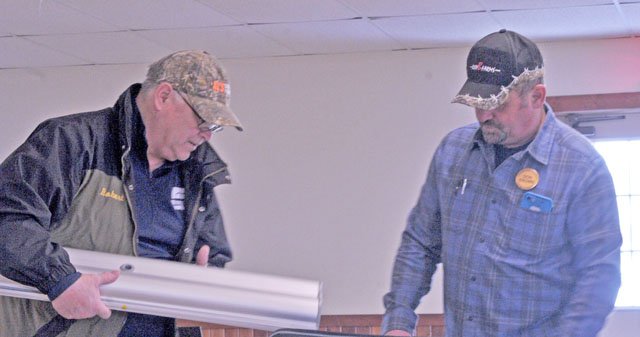

“Agriculture has a stake in water quality, and DATCP’s watershed council grants is a great program,” Brown told the group. “We need to let people know that we all want clean air and water, and profitable farms.”
Rushmann told the group that the program has been in existence for five years, and started out in 2016 with a budget of $250,000 for the grants. Now, in 2020, the budget for the program has been increased to $740,000. Rushmann said that there is also proposed legislation working its way through the system that could potentially increase that amount to $1 million for 2020.
“Is $740,000 enough to fund the program,” Representative Loren Oldenburg asked.
“There’s no question that we will be able to fund the full $740,000 in 2020,” Rushmann responded. “If it was increased to $1 million, I’m pretty sure there would be demand for the full amount.”
Rushmann asked participants the question, “Why are you here? Why are you interested in the program or conservation?”
Reponses included water quality; rain runoff and soil erosion; one participant said he monitors the water in the Kickapoo River in Wauzeka and has seen an increase in sediment in the river; soil health and water infiltration; and the use of cover crops to improve soils and stop the loss of grassed waterways.
How it works
Rushmann explained that in order to start a group and obtain the funding, five farmers who earn their livelihood from farming in a watershed have to step forward to be the sponsors. The group is not limited to five, but it takes a minimum of five to qualify for the funding.
She told the group that they could pick the watershed they want to focus on, and then find a way to reach out to other farmers in that watershed. She used the example of the Tainter Creek Watershed Council, which is funded through the DATCP program, which is a relatively small watershed.
“Applications are due in May or June, and I am willing to come back out and help any interested producers submit an application,” Rushmann explained. “The group will be required to have a memorandum of understanding with either DATCP, DNR, the county Land Conservation Department, UW-Extension or a non-profit group to receive and administer the funds. Matching funds of one-to-one are required, but some of that can come from in-kind contributions.”
Rachel Rushmann can be reached at 608-224-4622, or by e-mail at Rachel.rushmann@wisconsin.gov.
Rushmann explained that the groups that have received the funding have become a statewide network of farmers who are focused on conservation. She said that her office plans to offer regional trainings this year, and has also developed a webinar series on conservation topics.
Rushmann listed what she views as the components of success for producer-led watershed councils:
• Strong farmer leadership
• Diverse partnerships
• Diverse funding
• Outreach component
• Tracking progress to report on success
“In evaluating requests for funding, our department is looking for groups that propose things that are innovative, like planting green,” Rushmann said. “It is also important to prepare for when you may no longer have funding from DATCP by seeking to develop diverse partnerships with other organizations.”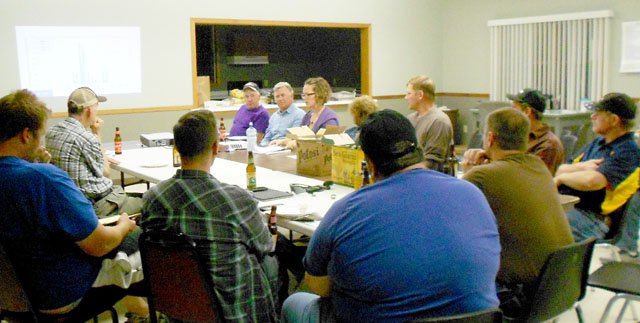
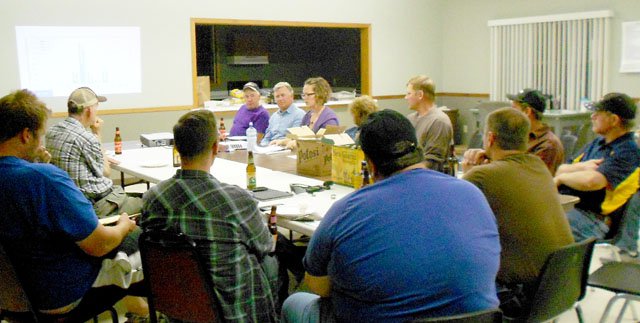
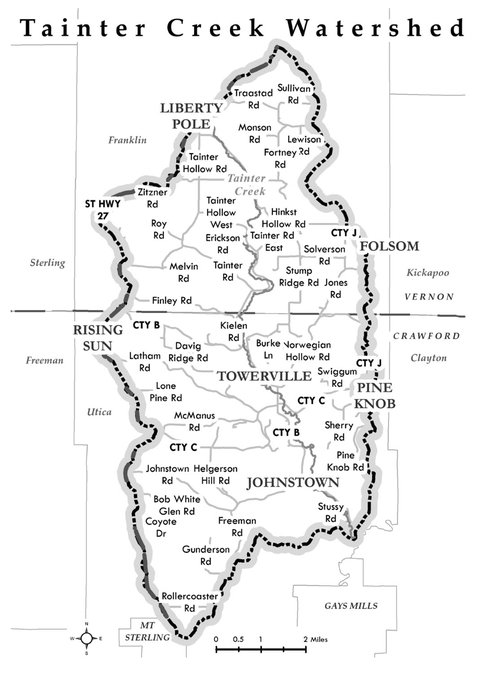
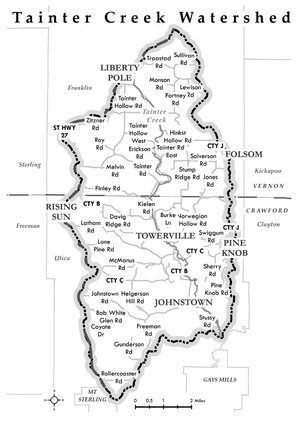
Local contacts
Locally, the most visible producer-led watershed council has been the Tainter Creek Watershed Council. The Tainter Creek Watershed is in Vernon County’s Franklin Township, and Crawford County’s Utica Township.
The group has received full funding from DATCP for the last three years, and meets more-or-less monthly, either at the Franklin Town Hall near Liberty Pole, or sometimes in Gays Mills. The next meeting of the group will take place on Thursday, March 12, at 7:30 p.m., at the Franklin Town Hall.
The group really got its start after a catastrophic rain event along the Vernon-Crawford county line in September of 2016 devastated farms, roads and crops in the watershed. Matt Emslie from Valley Stewardship Network went out and knocked on doors, and found farmers who were interested in seeing if there was something they could do to reduce the amount of water running off their fields.
In an announcement in the Independent-Scout in June of 2017, one of the watershed council’s founding farmers, Berent Froiland, put out a call for interested farmers to consider attending their next meeting:
“We are always looking for new ideas on how to help with land and water conservation, as well as educate others on different ways to protect soil and water,” Froiland said. “We have producers from all different backgrounds and are looking to get as many ideas as possible to help preserve the watershed. After last year's flood, we all saw the damage not only to the Tainter Creek, but also to our own property that eventually filters down to the creek.”
Some of the members of the watershed council include Bruce Ristow, Jake Wedeberg and Josh Engel from Crawford County; and Grant Rudrud, Brian McCulloh, Jeremy Nagel, Ryan and Dani Heisler-Woodill, Jeff Ostrem, and Mark Erickson from Vernon County.
The group brought retired USDA-NRCS soil scientist Ray Archuleta to the area for a soil health event in 2018; and followed it up with North Dakota farmer and soil health guru Gabe Brown in 2019. They have held a free kids fishing day event on Tainter Creek for the last two years, and plan to repeat that event again in 2020. They also held a ‘Fast and Flexible Fencing’ workshop at the Jeremy Nagel farm last summer. The group will hold another soil health education event this coming summer.
In addition to the education events sponsored by the council, they also partner with Valley Stewardship Network on surface water quality monitoring of Tainter Creek. They recently also conducted their second round of well water testing in the watershed. These efforts are aimed at developing a baseline of water quality in their watershed that they can measure the success of their efforts against over time. The group has also provided farmers in the watershed with funding for installation of cover crops.




